SURF, the collaborative organization for ICT in Dutch education and research, organized a study trip to the 2019 EDUCAUSE Learning Initiative (ELI) Annual Meeting to learn more about active learning spaces.
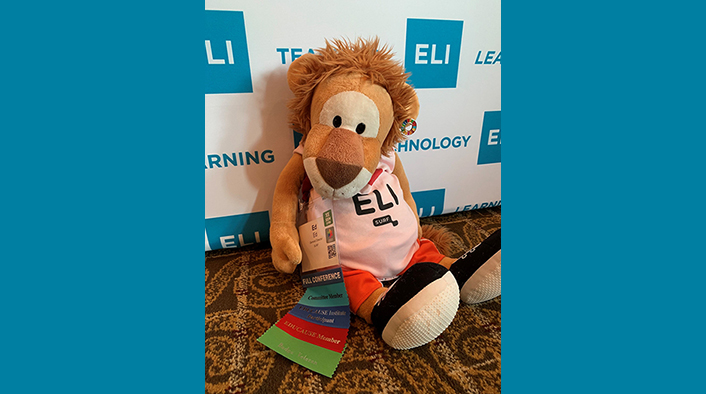
Active learning spaces are more than classrooms outfitted with technical gadgets; they offer extensive pedagogical opportunities to meet the needs of contemporary students through active learning and to help students develop relevant skills.
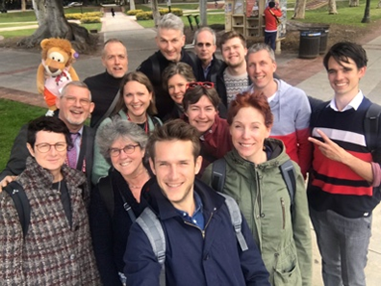
(Photo credit: Barend Last)
To learn more about active learning spaces, SURF, the collaborative organization for ICT (information and communications technology) in Dutch education and research, organized a study trip to the 2019 EDUCAUSE Learning Initiative (ELI) Annual Meeting in Anaheim, California. The various conference sessions on this topic offered a substantive picture of the possibilities of active learning spaces and how they can be optimally used in a college/university setting. In addition, through our visit to the campus of the University of California–Irvine, we saw how active learning spaces are being applied in practice.
Here we offer six important lessons learned for active learning spaces.
Lesson 1: Put Students at the Center
One important lesson confirmed at the ELI Annual Meeting is that the student experience must form the starting point for innovating classrooms. During the conference, Liv Gjestvang (Ohio State University) and Jennifer Sparrow (Pennsylvania State University) outlined the three most important qualities demanded of current students in relation to the ever-changing labor market:
- Students must think creatively and divergently.
- Students must possess digital literacy.
- Students must have the social skills to function well in teams in different cultural settings.1
To develop these skills, 21st-century students benefit greatly from active learning. As is perhaps expected, they are the target group, with the highest usage of educational spaces. It is therefore important to create educational spaces where students can develop creatively and learn from each other through active education. The active learning space provides students with variation and flexibility in educational modes. Instead of just listening passively to the instructor, they can be more actively involved in discussions, projects, and the lecture itself, which generates more in-class energy and shifts the overall dynamic from teacher-centered to student-centered. During our visit to the University of California–Irvine (UCI) campus, a representative reported that students even use the available active learning classrooms outside of scheduled lectures.
Many institutions give students the opportunity to provide input on learning spaces. For example, McGill University prepared its work plan with five principles for the design and implementation of learning spaces based on the National Student Survey for Student Engagement, a survey of students from 1,450 US institutions.2 Including students in the planning stages for, as well as in the implementation of, active learning spaces also helps to ensure that these spaces match students' goals and needs, which further influences academic impact.
Lesson 2: Use Active Learning Spaces to Facilitate Impactful Pedagogy
Sessions at the ELI 2019 annual meeting demonstrated that active learning spaces offer the pedagogical possibilities to teach students important skills of the future. The conference sessions and our subsequent visit to UCI showed our team a variety of spaces and different ways to use them.
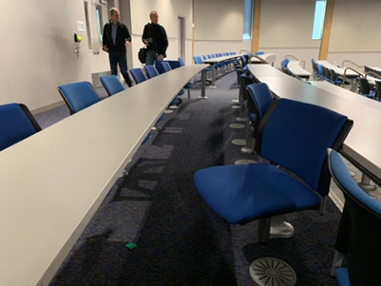
(Photo credit: Michel Jansen)
Various institutions gave examples of collaborative lecture halls, which are designed to promote active education and student interaction. For example, in two seemingly traditional UCI lecture halls, with capacity ranging from 250 to 400 students, seats attached to the tables could be rotated 180 degrees. This enabled students in small groups to discuss and collaborate with those seated in front of or behind them.
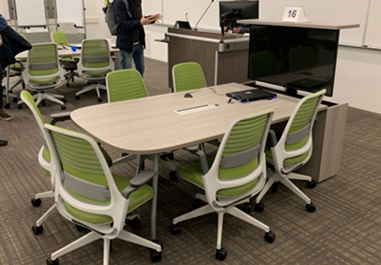
(Photo credit: Michel Jansen)
We also toured an active learning classroom for workgroup education. This space has a group layout with flexible furniture for up to 100 students. Here, students and instructors can experience a departure from regular lectures, where the educator is primarily the speaker or the "sage on the stage." Students and lecturers can take on different roles, with educators serving as guides or coaches while students take charge of their own learning experience.

(Photo credit: Steelcase)
Each wall in this classroom is equipped with whiteboards, and students have access to "huddle boards," small flexible whiteboards (approximately 18 x 24 inches). In addition, a screen setup is available for group use where students can simultaneously share laptop screens by logging in wirelessly through an app. In the freestanding group tables, the screen rises from the table. Educators can access all screens when necessary and share them with every student. This makes it easy to give different groups of students different assignments simultaneously. In addition, the screen-sharing equipment offers a variety of desks from which instructors can teach.
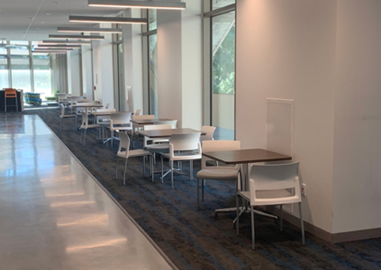
(Photo credit: Active Learning Institute, UCI)
There is also room for active learning outside the lecture hall in so-called informal learning spaces, which focus on both the individual learner and group collaboration. An example of this are small "huddle spaces": these group configurations include technological aids, where three to six students can work together on projects or assignments. UCI also has arranged groups of three or four comfortable seats and tables with electrical sockets in various locations for charging students' devices.
UCI has placed all of its active learning spaces in one central building: the Anteater Learning Pavilion. The advantage of doing so is that it provides students and teachers clarity on where active learning spaces are located and that students need less time to move between the several classrooms. However, alternatives are also possible, such as locating at least one active learning spaces per faculty member. To make a thorough decision, we have found it necessary to develop a broadly supported campus vision regarding the placement of active learning spaces.
Lesson 3: Incorporate Technology to Continually Enhance Active Learning Spaces
Different techniques and approaches can enhance the student experience:
- Audiovisual. Audiovisual technology and software within learning spaces enable further opportunities for more active education, in addition to the ongoing development of skills within these areas. Sample tools include document cameras, also known as visualizers, for recording written texts or displaying objects.
- Infrastructure. On a practical level, it's also important to provide robust technical infrastructure, ensuring that each student has access to power outlets and fast internet within the room. This type of room also meets the needs of today's student, who especially requires fast internet in a learning space.3
- Sound amplification. Ensuring quality sound reinforcement technology is critical. Examples include supplying sufficient microphones, making it easier for students to speak to the entire group, as well as a sound system that hearing-impaired students can connect to their hearing aids.
- Software programs. The available software in a learning space can contribute to greater interaction between educator and student and between students. Examples we saw during our study trip included screen-sharing and file-sharing software.
Technology within active learning spaces offers many possibilities, but it often also entails high costs. Most learning space technology has a shelf life of approximately five years. Furniture and equipment such as the huddle boards, flexible chairs, and tables discussed earlier last around twenty years.
An important consideration is, therefore, whether an institution will be outfitting a single room with entirely new technology or whether it is planning for a gradual implementation of new technology in all classrooms. At the ELI Annual Meeting, Richard Jones, an architect involved in the implementation of learning spaces at Harvard University, shared how a selection of lecture halls with varying levels of technological capability had promoted the overall acceptance of the technology used by the university's faculty and staff.4 Another discussion in various ELI sessions revolved around whether all functionalities of a room should be used immediately during an initial lecture so that students are aware of the technical possibilities, or whether educators should gradually integrate technology into their curriculum. Such teaching preferences must be carefully considered during the implementation phase of active learning spaces.
Continuous evaluation of the active learning space is key. Audiovisual techniques ensure that your learning spaces can evaluate constantly. Pennsylvania State University, for example, uses 360-degree cameras to analyze classes comprehensively. In addition, both UCI and Penn State use a specially developed observation protocol (COPUS) to test the functioning of these spaces through staff and student behavior. This has revealed, among other observations, that teachers in the active learning space were involved more as guides and coaches than they had been previously.5
Lesson 4: Supervise and Train Educators for Optimal Use of Each Space
At the ELI meeting, institutions indicated that convincing educators of the need for new learning spaces remains the biggest challenge. Educators must step out of their comfort zone and take an instructional approach that differs from what they've been accustomed to throughout their teaching careers. After having used the new spaces, however, educators were found to be very enthusiastic about the associated teaching potential.
To prepare educators for the array of instructional opportunities that active learning spaces present, many institutions offer relevant training. For example, UCI provided a module of eight meetings with educators on topics such as the didactics and technology behind the learning spaces. Following this experience, instructors received a certificate that gave them priority in reserving active learning spaces on campus. In addition, UCI approached those who had reserved a space to discuss how they envisioned its use. Due to the scarcity of available spaces, teachers often came up with specific plans if they were allowed to teach.
UCI also instituted an "innovation fund" as a means of involving educators. Through it, instructors are able to apply for innovative tools that they want to use during lectures in active learning spaces. In addition, UCI provided support by identifying senior students who had already taken the course and who could serve as technical assistants during classes. This gave instructors more freedom to focus on the efficacy of the active learning space while removing barriers to using it. The appointment of a vice provost for education, who championed the development of such learning spaces, also gave the spaces a huge boost on the UCI campus.
Lesson 5: Secure Institution-wide Support
When considering the implementation of active learning spaces, institutions must involve all relevant stakeholders. Through collaboration among teachers, students, and administrative departments, it is possible to garner the support needed for launching and maintaining active learning spaces on campus. Interestingly, research on the subject of professional development related to physical space has been conducted within both the TILE program at Iowa State University and the MOSAIC Initiative at Indiana University. Both case studies show that simply creating new learning spaces is not enough; involvement of all stakeholders within an institution is necessary to ensure that usage will be optimized and that support will be ongoing.6 Additionally, this helps to facilitate the type of systemic cultural change required in order for the introduction of such spaces to be truly successful.
Our team learned that pinpointing which roles within an institution should be responsible for the development of active learning spaces can sometimes be difficult. It is therefore essential to look for so-called champions within the institution; these are the early adopters who can create a shared awareness and sense of urgency for creating active learning spaces.
Lesson 6: Cross-Institutional Cooperation Pays Off
Another lesson is to ensure collaboration and knowledge sharing across institutions and consortia. It is better to learn from others in the field than to attempt to reinvent the wheel.
The Learning Space Rating System (LSRS), developed by EDUCAUSE, is an example of one system that can provide guidance in this area. A set of criteria has been developed through the LSRS to determine how well existing learning environments actively support learning. It offers a baseline measurement for entire campuses, from which an institution can determine what needs to be done to actively introduce learning into the physical learning environment. The LSRS is a rating system that enables institutions to compare their initiatives to best practices within the broader higher education community.
Another example of an initiative that strives to further advance the development of learning spaces is the Flexible Learning Environments Exchange (FLEXspace) [http://www.flexspace.org/]. FLEXspace has created a portal for an expert community of educators and library staff involved in the planning, design, and implementation of learning spaces. The portal serves as a digital hub for students and educators to exchange thoughts about learning spaces, best practices, and collaboration with colleagues from all over the world.
In Summary

(Photo credit: Michel Jansen)
Our team's study trip to the ELI 2019 annual meeting offered a helpful overview of the most recent possibilities for active learning spaces. These spaces provide opportunities for active learning to introduce lecture hall and workgroup space and thereby put the student at the center. Educators can and should involve students and guide them through the implementation. In addition, it is important to constantly develop active learning spaces with technology. The study trip also demonstrated that the successful implementation of active learning spaces requires not only support within an institution but cross-institutional knowledge exchange as well. With these insights in mind, we believe that active learning spaces have much to offer Dutch higher education.
This article was previously published in Dutch by SURF as Active Learning Spaces: Lessons Learned in de VS Vsverslag SURF Studiereis Naar ELI 2019.
For more insights about advancing teaching and learning through IT innovation, please visit the EDUCAUSE Review Transforming Higher Ed blog as well as the EDUCAUSE Learning Initiative page.
Notes
- Liv Gjestvang and Jennifer Sparrow, "How Higher Ed Can Cultivate Students to Lead the Future We Want to Live In," ELI Annual Meeting, Anaheim, California, February 20, 2019. ↩
- A. Finkelstein, J. Ferris, L. Winer, and C. Weston, "Principles for Designing Teaching and Learning Spaces" (Teaching and Learning Services, McGill University, 2014). ↩
- Anastasia S. Morrone, IUPUI Classroom Needs Analysis 2018 (Trustees of Indiana University, 2018). ↩
- Rick Jones, Jeanne Narum, and Parke Rhoads, "What Activates Learning? Space vs. Technology," ELI Annual Meeting, Anaheim, California, February 20, 2019. ↩
- Crystal Ramsay, Jenay Robert, and Kelly Scholl, "Learning Space Innovations to Influence Design and Understand Learning Experiences," ELI Annual Meeting, Anaheim, California, February 21, 2019. See also M. K. Smith, F.H.M. Jones., S. L. Gilbert S.L., and C. E. Wieman, "The Classroom Observation Protocol for Undergraduate STEM (COPUS): A New Instrument to Characterize University STEM Classroom Practices," CBE-Life Sciences Education 12, no. 4 (2013). ↩
- Anastasia Morrone, Anna Flaming, Tracey Birdwell, Jae-Eun Russell, Tiffany Roman, and Maggie Jesse, "Creating Active Learning Classrooms Is Not Enough: Lessons from Two Case Studies," EDUCAUSE Review, December 4, 2017. ↩
Stan Aalderink is a project manager at SURF.
© 2019 SURF. The text of this work is licensed under a Creative Commons BY 4.0 International License.
